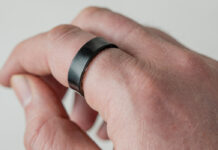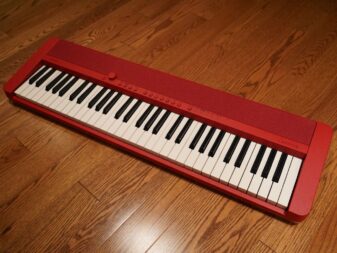 The Casiotone line is Casio’s beginner-friendly line of portable keyboards. The dozen or so models focus on portability and convenience. Amongst these, the three CT-S1 units are stylish, streamlined choices that make for a great first keyboard or a portable practice tool for experienced players. No matter where you are in your musical journey, it’s the type of model that’s good to have around. Keep reading to find out if this keyboard is for you.
The Casiotone line is Casio’s beginner-friendly line of portable keyboards. The dozen or so models focus on portability and convenience. Amongst these, the three CT-S1 units are stylish, streamlined choices that make for a great first keyboard or a portable practice tool for experienced players. No matter where you are in your musical journey, it’s the type of model that’s good to have around. Keep reading to find out if this keyboard is for you.
First of all, check out my review video that details my initial impressions and that includes some sound samples.
Stylish, minimalistic design
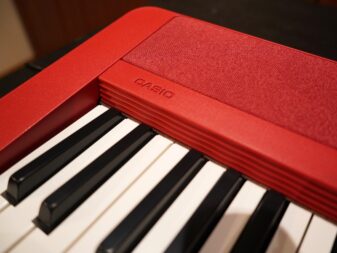 The first thing you’ll notice about the CT-S1 is how cool it is. I received a red keyboard, which looks great and is a cool colour, no matter which instrument you play. There are white and black alternatives if you prefer something more standard. The material that covers the speakers is really nice and has a cloth-like texture. Its colour is also slightly off from the plastic shell, for a very good-looking accent.
The first thing you’ll notice about the CT-S1 is how cool it is. I received a red keyboard, which looks great and is a cool colour, no matter which instrument you play. There are white and black alternatives if you prefer something more standard. The material that covers the speakers is really nice and has a cloth-like texture. Its colour is also slightly off from the plastic shell, for a very good-looking accent.
The model has 61 light keys. This helps make it quite portable and easy to carry. If you are a beginner, make sure you talk to your teacher about this fact. Some educators really insist on heavy, piano like action. It’s not that one or the other is better, it’s more about developing technique that can translate well to the acoustic type. Light keys are great for playing different sounds like organs and synths. They are also touch sensitive, which means they’ll react to the strength you use to play them. If you press hard, the volume will be louder and vice versa.
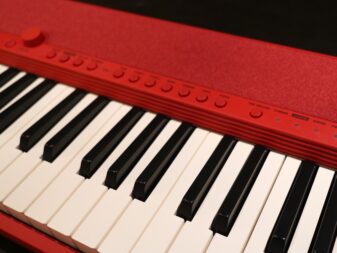 There are 61 built-in tones. These span a wide variety of instruments including: pianos, electric pianos, organs, harpsichords, clavinets, synths and more. You have access to a wide variety of tones on the keyboard itself (35 to be exact). To select the 26 others, you’ll need to hold down a button and select the desired sound with one of the 61 keys. To ease some of the navigating, there’s a handy Tone Memory, to store and instantly recall your most used sounds. Some of the choices are based on classic Casio timbres, which is great for such an affordable product.
There are 61 built-in tones. These span a wide variety of instruments including: pianos, electric pianos, organs, harpsichords, clavinets, synths and more. You have access to a wide variety of tones on the keyboard itself (35 to be exact). To select the 26 others, you’ll need to hold down a button and select the desired sound with one of the 61 keys. To ease some of the navigating, there’s a handy Tone Memory, to store and instantly recall your most used sounds. Some of the choices are based on classic Casio timbres, which is great for such an affordable product.
In addition to the different instruments, you’ll have access to a few effects. There is a choice of 24 different reverbs. You can also activate chorus and delay. For added depth, you can also activate the surround option that transforms the sound coming from the speakers into a more immersive experience.
Additional features include a layer function which lets you combine two tones, a metronome to solidify your time and technique and a MIDI recorder to store your song ideas or to listen back to your playing.
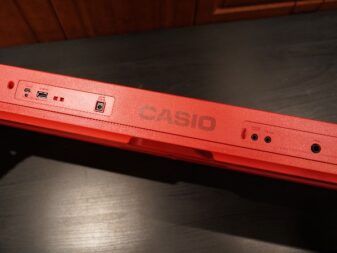 The back panel has simple connections that include an auxiliary in to play audio and an output/headphone jack to hook up to a PA system or for silent practice. Although it is sold separately, you can plug in a sustain pedal. There are also digital USB ports, for flash drives and to connect to computers. These don’t transmit audio signals, only MIDI. You’ll be able to store your saved performances or control external sound banks on your computer.
The back panel has simple connections that include an auxiliary in to play audio and an output/headphone jack to hook up to a PA system or for silent practice. Although it is sold separately, you can plug in a sustain pedal. There are also digital USB ports, for flash drives and to connect to computers. These don’t transmit audio signals, only MIDI. You’ll be able to store your saved performances or control external sound banks on your computer.
Bluetooth is not available, but it’s possible to use an optional adapter; the WU-BT10. It can transmit audio and MIDI data so you can wirelessly play music or connect to your smart device to use Casio’s Cordana Play app.
Lastly, there’s an interesting feature that you don’t find on many keyboards. On each side of the instrument, there are strap pins that you can use with a guitar strap, for example. This will help you play the keyboard in a sitting position when you don’t have access to a desk or stand. It’s great for people who travel a lot and end up in hotel rooms.
Limited Number of Features, but That Cover a Lot of ground
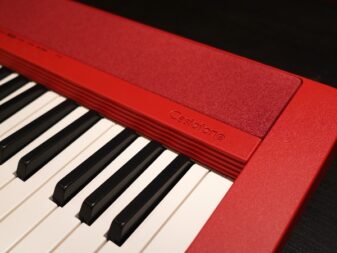 Compared to many models on the market, the CT-S1 doesn’t have a staggering number of sounds. Some products have hundreds of sounds and are in the same price range. That being said, this particular unit has great sounding samples. You can hear them in detail in my review video.
Compared to many models on the market, the CT-S1 doesn’t have a staggering number of sounds. Some products have hundreds of sounds and are in the same price range. That being said, this particular unit has great sounding samples. You can hear them in detail in my review video.
There aren’t a lot of features either. This can be a blessing in disguise for some easily distracted students. There aren’t many things to sidetrack you from practising. This is also true for current players that just want a simple, portable model to take their practice with them, wherever they go.
The limited number of buttons makes the keyboard a little difficult to navigate and set up. Depending on what you want to achieve, you’ll need to hold down a button and select the desired option through one of the 61 keys. This means you’ll be referring a lot to the manual, unless you manage to memorize the option layout. This is a bit of dag, especially if you are used to navigating a screen and a larger number of controls on the main panel itself.
Might Interest Different Types of Players
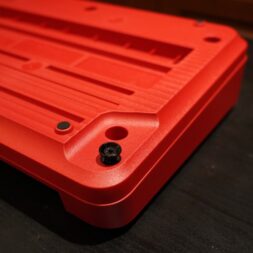 Beginners and young players who are eager to start playing will enjoy the CT-S1. It looks and sounds good and they won’t be distracted by endless features. For parents, it’s a good unit to test how much their child will enjoy learning and practising piano, without breaking the bank. Eventually, if they move on to a more complex instrument, this one can still be useful as a portable choice for the cottage or rehearsal at a friend’s house.
Beginners and young players who are eager to start playing will enjoy the CT-S1. It looks and sounds good and they won’t be distracted by endless features. For parents, it’s a good unit to test how much their child will enjoy learning and practising piano, without breaking the bank. Eventually, if they move on to a more complex instrument, this one can still be useful as a portable choice for the cottage or rehearsal at a friend’s house.
Although this model is mostly aimed at beginners, experienced players might be looking for a simple, streamlined model that is easy to carry. Some 88 note keyboards are just not practical for being on the move and such a unit might be what you need. If you’re looking for a tool to practise scales, arpeggios, chord progressions, repertoire or to write your own music, this will do just that. If you need more sounds, it’s easy enough to plug into your laptop and use external sound banks.
Check out the Casiotone CT-S1 by Casio on Best Buy’s website.

